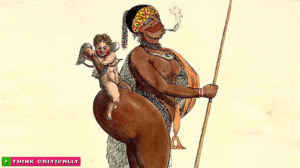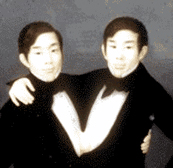
Credit: Wikipedia
Racea recent idea created by western Europeans following exploration across the world to account for... More science took a particularly insidious turn in the 19th century when non-Europeans were routinely the subject of so-called scientific exhibitions, carnivals and international fairs that purported to explore racial diversity and ethnicityan idea similar to race that groups people according to common origin or background. The... More. The exhibitions examined the notion of racial difference using displays of human beings, designed ostensibly to represent an evolutionary hierarchy. In many exhibits, people were grouped by skin color from the darkest to the lightest, or “lowest” to the “highest” on an evolutionary scale. These “expositions” were a major factor in perpetuating the idea that African, Asian, and Natives were inferior to Europeans and white Americans.
For Millie and Christine McCoy, conjoined twins who were billed as the Two-Headed Nightingale, life was much more difficult. Born into slaveryan extreme form of human oppression whereby an individual may "own" another person and the... More, they lived in North Carolina like conjoined twins Chang and Eng Bunker, but were taken from their family and sold several times. They were even put on public display by their owners who recognized the commercial value of the spectacle. The twins were bought by J.D. Smith when they were still toddlers, and he became their manager for stage appearances. The twins were kidnapped by a man Smith hired as their exhibitor while on display in New Orleans. Since the girls were now ‘stolen property,” public showings were out of the question, but they were still exhibited before exclusive private groups. Smith finally found the twins in London after a period of years, and after a protracted legal battle, regained control of them. They were a great success, billed as the “Two-Headed Lady” or the “Two-Headed Nightingale.” They spoke several languages fluently, and danced and sang songs as well. The twins were freed after the Civil War, but stayed with their former manager’s widow, earning more than six hundred dollars a week.
- Amsterdam held the Colonial Exhibition in 1883, which displayed twenty-eight Surinamese in its West Indies section. They were photographed extensively by Prince Roland Napoleon Bonaparte, who was a trained ethnologist and the grandson of Napoleon’s brother. Bonaparte’s career in ethnographic photography included photographic albums of North American Indians in 1887 and Lapons in 1890.
- The Midway Plaisance in Chicago was the major venue for exhibits of nonWestern cultures in the U.S. At the 1893 World’s Columbian Exposition, several African villages were constructed at the Midway fairground, where villagers were paraded up and down each day before being returned to their display areas. African Americans took exception to the racial stereotyping and constructed their own images of black communities. A pamphlet written by Ida B. Wells-Barnett, journalist and anti-lynching advocate, and abolitionist Frederick Douglass was published in several foreign languages; The Reason Why the Colored American Is Not in the World’s Columbian Exposition, expounded on the oppression of African Americans in both the North and
South. - The 1904 World’s Fair in St. Louis featured among other attractions a group of pygmies who had been brought in from the Belgian Congo. One of the pygmies was Ota Benga, who, after the exhibit was over, was sent to the Bronx Zoo. The director of the zoo, William T. Hornaday, believed he understood the thoughts of zoo animals. He believed Ota Benga was no different from any other animal in the ZOO, and insisted he was only showing an interesting exhibit. Crowds came to the monkey house exhibit, which opened in 1906, to see man’s “evolutionary ancestors,” which included monkeys, chimpanzees, a gorilla named Dinah, an orangutan named Dohung and the pygmy Ota Benga. Controversy swirled around the extremely popular exhibit, as religious figures objected to the theme of evolutionthe transformation of a species of organic life over long periods of time (macroevolution) or... More, and the black community was outraged at the treatment of Benga. As a legal compromise, Ota Benga was allowed to leave his cage and walk around the zoo in a white suit; but he returned to the monkey house at night. The pygmy was angered by his treatment, and retaliated in various ways, including brandishing a knife around the park and shooting visitors with a small bow and arrow. This behavior led to his expulsion from the park, and he was sent to the Virginia Theological Seminary and College, which he soon left for work in a tobacco factory. Eventually his depression and anger became too much for the pygmy, and he shot himself in the heart with a borrowed revolver in 1916.
Related Posts

Credit: North Carolina Collection, University of North Carolina Library at Chapel Hill
“The Siamese Double Boys”
Chang and Eng (shown above) were billed as the “Siamese Double Boys” in their first U.S. appearance in
Boston.
Chang and Eng were brothers born in Siam (now Thailand), whose condition as conjoined twins became the basis for the term Siamese twins. Born in the province of Samut Songkhram, to a Chinese father and an ethnic Chinese/Malay mother, the twins were joined at the sternum by a small piece of cartilage. Their livers were fused but independently complete. However, the medical technology of the 19th century did not allow them to easily be separated. In 1829, a British merchant exhibited the two as a curiosity during a world tour. Upon termination of their contract, they went into business for themselves and joined P.T. Barnum. In 1839, while visiting Wilkesboro, North Carolina, with P.T. Barnum, the twins settled there, becoming U.S. citizens.
The brothers married two sisters, lived on a plantation, bought slaves and adopted the name Bunker. Chang and his wife had ten children; Eng and his wife had twelve. The two set up separate households and alternated, spending three days at each home. During the Civil War, both their sons fought for the Confederacy. The twins died on the same day in 1874.




